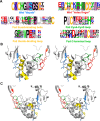Structure-based prediction of Wnt binding affinities for Frizzled-type cysteine-rich domains
- PMID: 28533339
- PMCID: PMC5500790
- DOI: 10.1074/jbc.M117.786269
Structure-based prediction of Wnt binding affinities for Frizzled-type cysteine-rich domains
Abstract
Wnt signaling pathways are of significant interest in development and oncogenesis. The first step in these pathways typically involves the binding of a Wnt protein to the cysteine-rich domain (CRD) of a Frizzled receptor. Wnt-Frizzled interactions can be antagonized by secreted Frizzled-related proteins (SFRPs), which also contain a Frizzled-like CRD. The large number of Wnts, Frizzleds, and SFRPs, as well as the hydrophobic nature of Wnt, poses challenges to laboratory-based investigations of interactions involving Wnt. Here, utilizing structural knowledge of a representative Wnt-Frizzled CRD interaction, as well as experimentally determined binding affinities for a selection of Wnt-Frizzled CRD interactions, we generated homology models of Wnt-Frizzled CRD interactions and developed a quantitative structure-activity relationship for predicting their binding affinities. The derived model incorporates a small selection of terms derived from scoring functions used in protein-protein docking, as well as an energetic term considering the contribution made by the lipid of Wnt to the Wnt-Frizzled binding affinity. Validation with an external test set suggests that the model can accurately predict binding affinity for 75% of cases and that the error associated with the predictions is comparable with the experimental error. The model was applied to predict the binding affinities of the full range of mouse and human Wnt-Frizzled and Wnt-SFRP interactions, indicating trends in Wnt binding affinity for Frizzled and SFRP CRDs. The comprehensive predictions made in this study provide the basis for laboratory-based studies of previously unexplored Wnt-Frizzled and Wnt-SFRP interactions, which, in turn, may reveal further Wnt signaling pathways.
Keywords: Frizzled receptor; Wnt signaling; cysteine-rich domain; homology modeling; lipid-protein interaction; protein-protein interaction; structural biology; structure-activity relationship.
© 2017 by The American Society for Biochemistry and Molecular Biology, Inc.
Conflict of interest statement
The authors declare that they have no conflicts of interest with the contents of this article.
Figures






Similar articles
-
Wnt Binding Affinity Prediction for Putative Frizzled-Type Cysteine-Rich Domains.Int J Mol Sci. 2019 Aug 26;20(17):4168. doi: 10.3390/ijms20174168. Int J Mol Sci. 2019. PMID: 31454915 Free PMC article.
-
Wnt5a promotes Frizzled-4 signalosome assembly by stabilizing cysteine-rich domain dimerization.Genes Dev. 2017 May 1;31(9):916-926. doi: 10.1101/gad.298331.117. Epub 2017 May 25. Genes Dev. 2017. PMID: 28546512 Free PMC article.
-
Secreted Frizzled-related protein potentiation versus inhibition of Wnt3a/β-catenin signaling.Cell Signal. 2014 Jan;26(1):94-101. doi: 10.1016/j.cellsig.2013.09.016. Epub 2013 Sep 28. Cell Signal. 2014. PMID: 24080158 Free PMC article.
-
Beyond Wnt inhibition: new functions of secreted Frizzled-related proteins in development and disease.J Cell Sci. 2008 Mar 15;121(Pt 6):737-46. doi: 10.1242/jcs.026096. J Cell Sci. 2008. PMID: 18322270 Review.
-
Fatty acid recognition in the Frizzled receptor family.J Biol Chem. 2019 Jan 11;294(2):726-736. doi: 10.1074/jbc.REV118.005205. Epub 2018 Dec 10. J Biol Chem. 2019. PMID: 30530496 Free PMC article. Review.
Cited by
-
The Role of Wnt Signalling in Angiogenesis.Clin Biochem Rev. 2017 Nov;38(3):131-142. Clin Biochem Rev. 2017. PMID: 29332977 Free PMC article. Review.
-
Epigenetics of SFRP1: The Dual Roles in Human Cancers.Cancers (Basel). 2020 Feb 14;12(2):445. doi: 10.3390/cancers12020445. Cancers (Basel). 2020. PMID: 32074995 Free PMC article. Review.
-
Exploring DIX-DIX Homo- and Hetero-Oligomers in Wnt Signaling with AlphaFold2.Cells. 2024 Oct 3;13(19):1646. doi: 10.3390/cells13191646. Cells. 2024. PMID: 39404409 Free PMC article.
-
Sfrp4 and the Biology of Cortical Bone.Curr Osteoporos Rep. 2022 Apr;20(2):153-161. doi: 10.1007/s11914-022-00727-w. Epub 2022 Feb 19. Curr Osteoporos Rep. 2022. PMID: 35182301 Free PMC article. Review.
-
Protein-Protein interaction network analyses of human WNT proteins involved in neural development.Bioinformation. 2019 Apr 30;15(5):307-314. doi: 10.6026/97320630015307. eCollection 2019. Bioinformation. 2019. PMID: 31249432 Free PMC article.
References
Publication types
MeSH terms
Substances
Associated data
- Actions
LinkOut - more resources
Full Text Sources
Other Literature Sources

